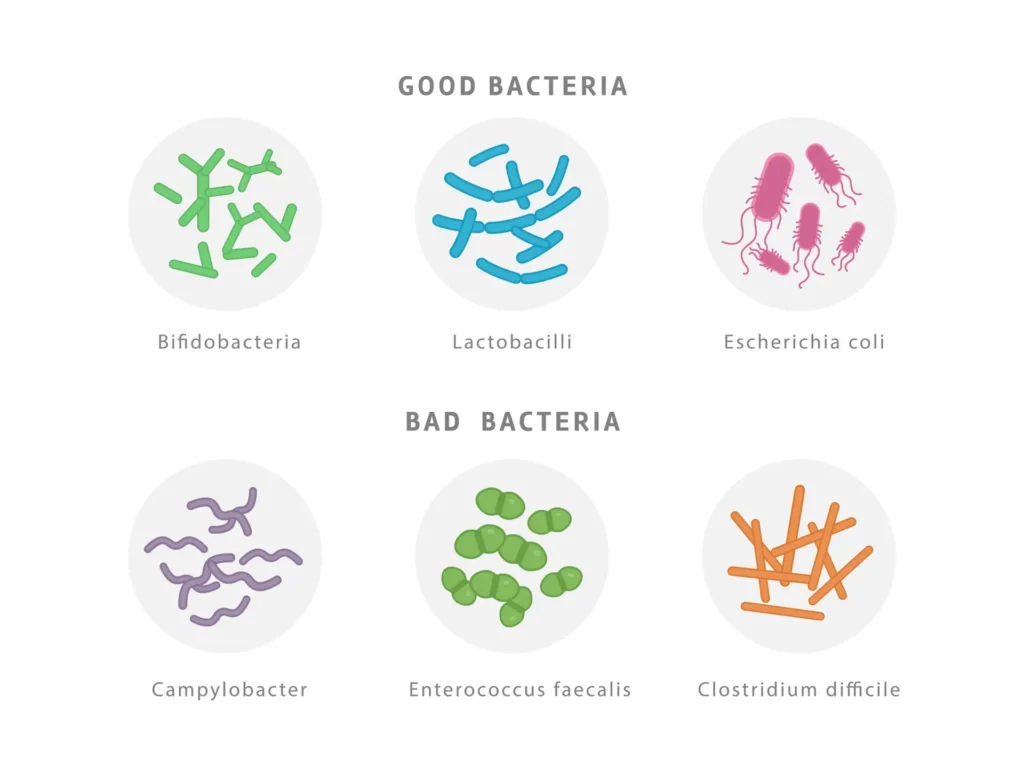Types of Bacteria
1. Bifidobacteria
Bifidobacteria are a group of beneficial, or “good,” bacteria that reside mainly in the human intestines. They are a key component of the gut microbiota and are essential for digestive health and immune system support.
- Where They’re Found: Bifidobacteria are found in the colon and also present in fermented foods like yogurt, kefir, and certain dietary supplements.
- Health Benefits:
- Help in the digestion of dietary fiber and complex carbohydrates.
- Produce short-chain fatty acids, which contribute to gut health and reduce inflammation.
- Play a role in preventing the growth of harmful bacteria by producing acids that lower the pH of the gut.
- Common Strains: Bifidobacterium longum, Bifidobacterium breve, and Bifidobacterium infantis.
Bifidobacteria are particularly beneficial for infants, as they make up a significant portion of the gut flora in breastfed babies and help develop a strong immune system.
2. Lactobacilli
There are another group of beneficial bacteria, known for their role in maintaining a healthy balance of bacteria in the gut, as well as in the urogenital tract.
- Where They’re Found: Lactobacilli are present in the intestines, mouth, and female reproductive tract. They are also found in fermented foods like yogurt, sauerkraut, and kimchi.
- Health Benefits:
- Help break down lactose, the sugar found in milk, into lactic acid, which can benefit those with lactose intolerance.
- Produce lactic acid that inhibits the growth of harmful pathogens in the digestive and urinary tracts.
- Support the immune system and aid in preventing digestive disorders, such as diarrhea.
- Common Strains: Lactobacillus acidophilus, Lactobacillus rhamnosus, and Lactobacillus reuteri.
Lactobacilli play a key role in probiotics because they positively impact digestive health and help restore balance in the gut microbiome after antibiotic treatment.
3. Escherichia coli (E. coli)
Escherichia coli, or E. coli, is a type of bacteria that naturally resides in the intestines of humans and animals. Most strains are harmless and play a role in digesting food; however, some strains can be harmful and cause serious illness.
- Where They’re Found: E. coli is found in the intestines of humans and animals and can be present in contaminated food or water.
- Roles and Risks:
- Harmless strains, such as E. coli K12, are part of the normal gut flora and aid in digestion.
- Pathogenic strains, such as E. coli O157, can cause severe foodborne illnesses, leading to symptoms like diarrhea, abdominal pain, and vomiting.
- How It Spreads: E. coli infections are commonly spread through contaminated food, undercooked meat, raw vegetables, and unpasteurized milk.
While most E. coli strains are beneficial, it’s essential to prevent infection by practicing good food hygiene, cooking meat thoroughly, and avoiding unpasteurized products.
4. Campylobacter
Campylobacter is a genus of bacteria that is one of the most common causes of foodborne illness worldwide. Consuming contaminated food, particularly undercooked poultry, typically spreads these bacteria.
- Where They’re Found: Campylobacter bacteria commonly inhabit the intestines of poultry, cattle, and other animals. Humans can encounter them through contaminated food, water, or contact with infected animals.
- Health Risks:
- Campylobacter jejuni and Campylobacter coli are the most common species causing human illness.
- Symptoms of infection, known as campylobacteriosis, include diarrhea (often bloody), fever, abdominal cramps, and vomiting.
- In rare cases, infection can lead to more severe complications, such as Guillain-Barré syndrome, a neurological disorder.
- How to Prevent Infection: Proper food handling, cooking meat to safe temperatures, and avoiding cross-contamination in the kitchen can prevent Campylobacter infections.
Campylobacter infections are typically self-limiting, but severe cases may require antibiotic treatment.
5. Enterococcus faecalis
Enterococcus faecalis is a type of bacteria that normally inhabits the gastrointestinal tract. While it can be harmless, it also causes infections, especially in hospital settings.
- Where They’re Found: E. faecalis is found in the intestines of humans and animals. It can also be found in soil, water, and plants.
- Health Risks:
- In healthy individuals, E. faecalis usually does not cause harm, but it can lead to infections in immunocompromised patients.
- It causes infections in the urinary tract, bloodstream (bacteremia), and wounds.
- E. faecalis is a common cause of nosocomial infections (infections acquired in hospitals), where antibiotic-resistant strains, such as vancomycin-resistant enterococci (VRE), pose significant treatment challenges.
- Prevention: Good hygiene, careful monitoring of hospital patients, and proper use of antibiotics are key to preventing Enterococcus infections.
6. Clostridium difficile (C. difficile)
Clostridium difficile, or C. difficile, is a type of bacteria that can cause severe gastrointestinal problems, particularly in people who have recently taken antibiotics.
- Where They’re Found: C. difficile thrives in the environment, especially in soil, and lives in the intestines of some healthy people.Healthcare settings, such as hospitals and nursing homes, often encounter this bacterium.
- Health Risks:
- C. difficile can cause colitis, an inflammation of the colon, leading to severe diarrhea, fever, and abdominal pain.
- The use of antibiotics often triggers C. difficile growth by disrupting the normal gut flora, allowing the bacteria to grow unchecked.
- In severe cases, C. difficile infections can lead to life-threatening conditions such as toxic megacolon.
- Prevention: To reduce the risk of C. difficile infection, careful antibiotic use, hand hygiene, and proper cleaning of healthcare environments are critical.
Doctors treat C. difficile infections with specific antibiotics, and in some cases, they use fecal microbiota transplantation (FMT) to restore the balance of healthy bacteria in the gut.
